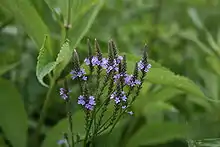Verbena hastata
Verbena hastata (American vervain,[1] blue vervain or swamp verbena) is a flowering plant in the vervain family, Verbenaceae. It is a herb with opposite, simple leaves which have double-serrate margins, borne on stiffly erect, branching square stems. The purple flowers appear in summer. This is a common plant that occurs across North America. It is hardy and drought resistant.[2]
| Verbena hastata | |
|---|---|
 | |
| Scientific classification | |
| Kingdom: | Plantae |
| Clade: | Tracheophytes |
| Clade: | Angiosperms |
| Clade: | Eudicots |
| Clade: | Asterids |
| Order: | Lamiales |
| Family: | Verbenaceae |
| Genus: | Verbena |
| Species: | V. hastata |
| Binomial name | |
| Verbena hastata | |
This species is a member of the diploid North American vervains which have 14 chromosomes altogether. Hybridization seems to have played some role in its evolution, presumably between some member of a group including the white vervain (V. urticifolia), V. lasiostachys or V. menthifolia, and V. orcuttiana or a related species.
In the recent evolutionary past, there has been an incident of chloroplast transfer of one of the latter or the swamp verbena to the mock vervain Glandularia bipinnatifida which is a close relative of the genus Verbena. It is unknown by what mechanism this happened, but it is suspected that hybridization is not responsible.[3]
It is a larval host to the common buckeye butterfly.[4]
Footnotes
- "BSBI List 2007". Botanical Society of Britain and Ireland. Archived from the original (xls) on 2015-01-25. Retrieved 2014-10-17.
- "Blue Vervain Wildflowers".
- Yuan & Olmstead (2008)
- The Xerces Society (2016), Gardening for Butterflies: How You Can Attract and Protect Beautiful, Beneficial Insects, Timber Press.
References
| Wikimedia Commons has media related to Verbena hastata. |
- Yuan, Yao-Wu & Olmstead, Richard G. (2008): A species-level phylogenetic study of the Verbena complex (Verbenaceae) indicates two independent intergeneric chloroplast transfers. Molecular Phylogenetics and Evolution 48(1): 23–33. doi:10.1016/j.ympev.2008.04.004